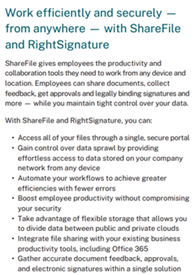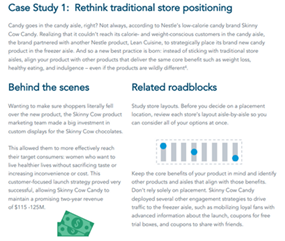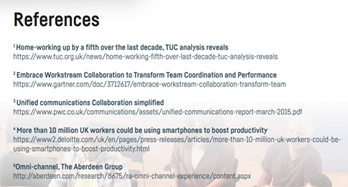 Every step of a white paper needs to help your reader to make an informed decision.
Every step of a white paper needs to help your reader to make an informed decision.
It must match your marketing challenges, be structured to generate leads, address your target audience, define the scope, present evidence, offer a conclusion, and contain an effective call to action. Then it needs a proven argument and a logical structure to hold together.
Too many marketers skip some – or all – of these steps. How can you make sure your white paper is one that your prospects will turn to time and time again?
Here are seven steps to creating a white paper that attracts attention and influences readers.
1. Pick the right type
Choosing the type based on your target audience is the best way to match your white paper with your marketing goals. Gordon Graham, author of White Papers for Dummies, has written over 300 white papers for companies like Google and Verizon.
Choose the most suitable white paper type based on your target audience, says @WhitePaperGuy via @SarahLParkerUK @CMIContent. Click To TweetHe says that, fundamentally, there are three types of white papers:
- Problem-solution
- Numbered list or listicle
- Product backgrounder
Let’s look at how each of these types works:
Problem-solution white papers generate leads
“(These white papers are) the most powerful for generating fresh leads at the start of the customer journey because prospects will Google their problem, not your product name,” Gordon says.
The problem-solution type allows you to walk through the drawbacks, limitations, unintended consequences, and tradeoffs of traditional solutions. For example, consider this white paper from Kinaxis, How CIOs Can Improve Supply Chain Management. It details four limitations of legacy planning, such as unsophisticated forecasts.

Kinaxis focuses on business and technical limitations to show it understands the industry. This helps buyers compare and contrast alternatives.
Numbered lists or listicles get attention and nurture prospects
Numbered lists present a set of issues, points, questions, or tips. “The listicle is best for engaging or re-engaging a prospect in the middle of their customer journey,” Gordon explains.
For example, this white paper from officemorph, 13 Mistakes to Avoid When Building Out Your Next Office, runs through common mistakes to cast doubt on alternative solutions and specify the ideal selection criteria. For example, mistake one is bidding out the project.

Product backgrounders support a product launch or evaluation
“This type goes into the features and benefits of a specific offering, and that’s fine as long as you don’t put it in front of prospects too early in their journey before they want it. Then, it’s just a sales pitch,” Gordon says.
This example from Explorance, Analyzing Student Comments in Online Course Evaluations with Blue Text Analytics, details the problem and technical advantages of a specific production solution to help the reader. In this excerpt, the company addresses the challenge of inputting open-ended comments by defining them, explaining how it’s gathered, and detailing the benefits it provides.

In this type of white paper, you design it to match your goals. “See how that works? And why you have to use the right type at the right point in the customer journey?” Gordon says.
“So when you find a product-focused white paper, that’s not necessarily a bad thing. They’re easier to do. But they will flop at lead-gen or engagement if that’s the only type a company ever does.”
2. Structure it to generate leads
A good white paper follows a structure. Brian Boys, author of How to Write a White Paper in One Day, has more than 25 years of experience writing white papers.
“It’s not just having a detailed outline before you start writing – that’s important. But it’s knowing exactly how each part of the white paper functions in sequence,” he says. “The job of each section is to convince the reader on a particular point and then compel them to read the next section.”
The job of each section in a white paper is to convince the reader on a particular point and then compel them to read the next section, says @BrianBoys via @SarahLParkerUK @CMIContent. Click To TweetKinaxis follows a fairly typical white paper structure for How CIOs Can Improve Supply Chain Management. Look closely and notice it:
- Covers market drivers contributing to the reader’s problem
- Scopes a problem occurring when the solution is not used
- Provides a historical overview reviewing traditional solutions
- Identifies a recommended solution but never mentions a company or product name
- Includes the benefits relevant to the reader’s problem
- Creates a checklist of what to look for in the new solution
- Introduces a call to action to move the reader to the next step
Though Kinaxis chose not to write about its solution, Citrix does this well in Think Beyond File Storage to Accelerate Business Efficiency. It explains how its ShareFile and Right Signature products give access to all files through a single, secure portal, give control over data sprawl, automate workflows, boost productivity, take advantage of flexible storage, and gather accurate document feedback and approvals.
You can also use a generic example or case study to illustrate real scenarios, as Shopkick does in its white paper, What Top CPG Brands Have To Teach Us About Successful Product Launches. For example, part of the white paper includes a case study about rethinking traditional store positioning, detailing the topic, going behind the scenes, and describing related roadblocks.
“You must have a clear foundation and canvas to paint on,” says Sarah Greesonbach, founder of the B2B Writing Institute.
“With a standard structure doing 60% of the work for you – organizing your notes, outlining your thoughts, providing a persuasive argument – then you can roll back on your heels and study the topic, crafting content that is the product of deep thought.”
With a standard white paper structure doing 60% of the work, you can roll back on your heels and study the topic, says @B2BWritingInst via @SarahLParkerUK @CMIContent. Click To Tweet3. Craft an attention-grabbing title
If choosing the most relevant white paper type is the best way to persuade readers, then crafting a powerful title is how you compel them to read it.
This is a point that Robert Bly, author of The Copywriter’s Handbook, has been writing about for four decades. “Strong titles can help you gain the reader’s attention, select the audience, communicate an important message, and draw the prospect into your white paper,” he says.
Strong titles can help you gain the reader’s attention, select the audience, communicate an important message, and draw the prospect into your white paper, says @Robertbly via @SarahLParkerUK @CMIContent. Click To TweetFor example, Gartner crafted a highly specific headline for its white paper (gated), What Midsize Enterprise CIOs Need to Know About Composable ERP:

It identifies the ideal reader (CIOs), the target market (midsize enterprise), and the subject (composable ERP). Then the audience is propelled into a sense of urgency by a call to action that sits in the present tense (need to know).
Although Gartner’s title doesn’t flag benefits or outcomes, it creates curiosity to pull the reader into the content. CIOs will want to find out what it is that they “need to know” to support their business. They are drawn to the content to satisfy their curiosity.
If your target reader doesn’t find any relevance in your title after a few seconds, they will move on, no matter how valuable your white paper.
4. Write a persuasive executive summary
Once you have your reader’s attention, an executive summary is how you help them to recognize their problem so that they can solve it.
Rachel Foster, CEO of Fresh Perspective Copywriting, has spent years writing white papers to help B2B technology marketers generate high-quality leads. She says, “The two most common executive summaries used in white papers are the preview and the synopsis.”
Provide a teaser preview
“It often discusses the market drivers and challenges that make the topic relevant,” Rachel says. “Then, it hints at what the reader will learn without giving away the bulk of the content.”
For example, consider this preview executive summary in Simply NUC’s white paper (not available online), Will a Mini PC Give You the Power You Need to Run Your Organization? It walks top-of-the-funnel readers through the market context (need to increase productivity), the problem (inefficient computers), its implications for businesses (energy-wasting), and promises a solution (mini PCs).

Publish a synopsis
“A synopsis provides an overview of the white paper’s content, including the recommended solution,” Rachel explains. This works better for bottom-of-the-funnel audiences because they are ready to buy.
This example from another Simply NUC white paper (gated), How to Empower Your Employee Workforce and Boost Business Efficiencies with Intel® NUC, details the argument – from market context to the solution and results.
Take the time to frame your choice of executive summary within your audience’s context, especially given the pace of change in marketing.
“I used to prefer preview summaries, as I didn’t want to give everything away,” Rachel says. “I now feel that the summary should provide key information upfront. If you withhold the most important information for later in the white paper, a large percentage of your audience may not read it.”
It’s a mistake to withhold the most important information until later in the white paper, a large percentage of your audience may not read it, says @B2BTechCopy via @SarahLParkerUK @CMIContent. Click To Tweet5. Present facts and evidence
A strong white paper convinces your audience with facts and evidence drawn from credible sources. Susan LaPoint, founder of Focal Point Content, has spent decades as a writer, editor, and content marketer. “When collecting evidence for a white paper, I find it useful to think like a journalist,” she says. “This means doing the research first to get a big picture view of the facts. Then I see how it relates to the story I’m telling.”
Find evidence for your white paper that reinforces the story you’re telling, says @SusanLaPoint via @SarahLParkerUK @CMIContent. Click To TweetTo persuade your reader, make sure the evidence is compelling. “Citing credible sources is key. I start by looking for original research – meaning from well-known research firms and publications,” Susan says. “You establish trust by including reliable data, as well as case studies and quotes from industry experts.”
Consider this white paper, Unlock the Agile Workspace from Six Degrees, which highlights key statistics and leverages industry sources and analysts such as the TUC, Gartner, PWC, and Deloitte. This image details the references used in the white paper with titles and links.
You can find trustworthy sources by:
- Using industry journals, leading analysts, and research reports
- Searching authoritative industry sites for your topic keywords
- Creating a list of sources that provide the best data that you refer to each time you write a white paper
- Using research brand names as keywords such as “Gartner” or “IDC” to Google search for your topic to quickly locate gated data in press releases
White papers are created to educate readers, so building trust by using recent research is best. Within the past two years is a good benchmark for fast-paced industries. “Trust is how you build your case and influence your reader to act,” Susan says.
6. Offer a conclusion
Once you have made your argument, think about what your key message is.
Sarah Mitchell, co-founder at Typeset, is an experienced white paper writer and content marketer. She says the goal of a white paper is to help your readers make an informed decision.
“If you’ve written persuasively throughout your white paper, the logical conclusion for the reader will be the exact product or service you offer,” Sarah says.
For example, Acquire’s white paper How Geoscience Data Can Shape the Future of Mining (gated) puts forward a conclusion that places its solution at the heart of the reader’s success. It explains how early adopters are well-placed for the future of mining and concludes by inviting the reader to send an email for more information and to schedule a meeting to discuss their data collection environment and how they can benefit from this solution.

This conclusion speaks to the reader’s pain point – keeping pace with market change – and offers a fundamental business case for the shift to integrated data capture.
Writing a conclusion that speaks directly to your target reader’s needs and motivations increases your chances of influencing them. “This is your opportunity to explicitly show your readers why your company is the smart choice by tying your offering back to the business case you’ve made,” Sarah says.
Use your white paper’s conclusion to explicitly show your readers why your company is the smart choice by tying your offering back to the business case you’ve made, says @SarahMitchellOz via @SarahLParkerUK @CMIContent. Click To Tweet7. Include a call to action
To give your white paper the best chance of moving the reader to the next step in the sales cycle, include a CTA.
Barry Feldman, founder of Feldman Creative, has 25 years of experience writing powerful lead magnets. “Put some thought into offering a clear and practical CTA at the conclusion of your white paper – or even within its pages,” he says.
“Often, a white paper is going to be a top-of-the-funnel piece,” Barry explains. “And, though it’s probably crafted to position your organization as an expert in its field, it’s also likely it was created to put readers on the path to resolving a specific challenge.”
Here are a few examples of CTAs that make it easy for the reader to take the next step:
- Connect with an expert
- Complete an application
- Watch a video
- Read a research report
You need to base your CTA on the readers’ needs and motivations. What action do they need to take to achieve their goal? What is the benefit to them? How do they get started?
Look at this CTA from Leadsquared (gated):

It identifies an action (schedule a free demo), a solution (patient-first platform), and the product or company (LeadSquared). Disclosing the demo is free and reduces friction.
The secret to a successful white paper CTA is to put the customer first. “As with all content, don’t be pushy. Be eager to address your reader’s pain point and be generous with your advice,” Barry says.
The secret to a successful white paper CTA is to not be pushy. Instead, address your reader’s pain point and be generous with your advice, says @FeldmanCreative via @SarahLParkerUK @CMIContent. Click To TweetWill your white paper succeed?
Not only can a white paper help you to add value to your reader – and subtly identify solutions that won’t – it also is a powerful addition to your content marketing strategy. A white paper can become the single resource that has the biggest impact on an organization’s buying decision as it is forwarded from stakeholder to stakeholder.
For marketers who want to establish meaningful thought leadership that generates leads, a white paper is the best way to attract and influence an audience.
Cover image by Joseph Kalinowski/Content Marketing Institute





